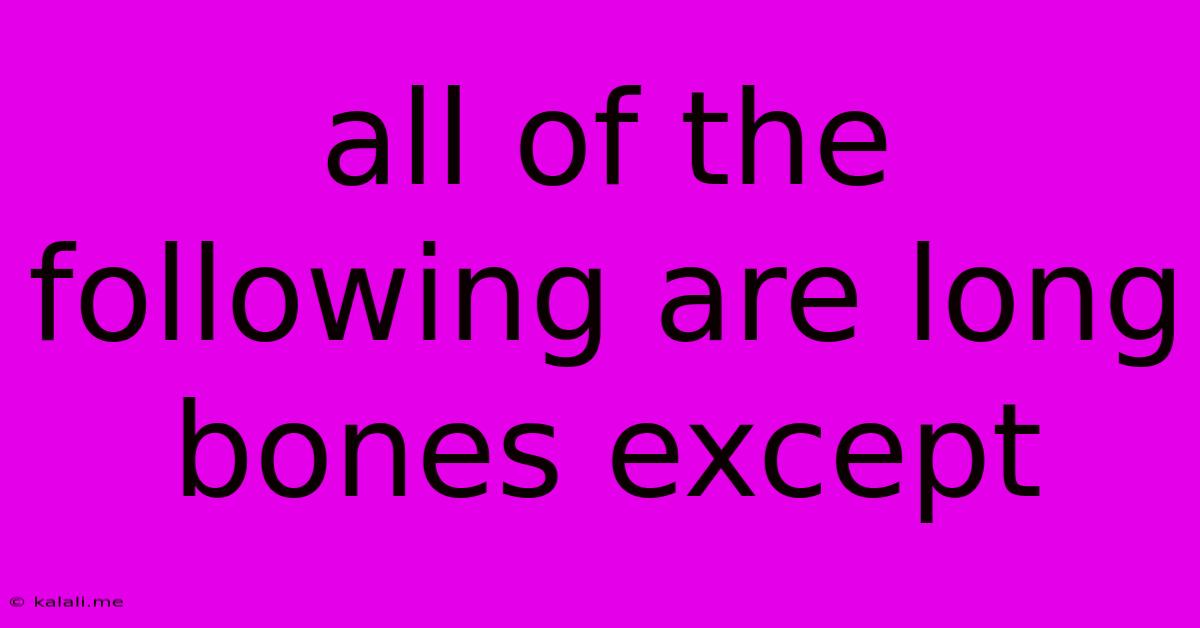All Of The Following Are Long Bones Except
Kalali
Jun 15, 2025 · 3 min read

Table of Contents
All of the Following Are Long Bones Except: Understanding Bone Classification
Understanding bone classification is crucial for anyone studying anatomy, physiology, or related fields. This article will delve into the characteristics of long bones and explore which bones don't fit this category. We’ll also cover the different types of bones found in the human skeletal system.
Long bones are defined by their elongated shape, with a shaft (diaphysis) and two ends (epiphyses). They are longer than they are wide and play a vital role in movement and support. But not all bones in the human body conform to this structure. This article will help clarify which bones are considered long bones and which aren't.
What Are Long Bones?
Long bones are characterized by their cylindrical shape and relatively long length compared to their width. Key features include:
- Diaphysis: The long, cylindrical shaft of the bone. This is primarily composed of compact bone, providing strength and structural integrity.
- Epiphyses: The two ends of the bone. These are wider than the diaphysis and contain spongy bone, which is lighter and has a higher surface area for bone marrow.
- Metaphyses: The regions where the diaphysis and epiphyses meet. In growing bones, this area contains the epiphyseal plate (growth plate), responsible for longitudinal bone growth.
- Articular Cartilage: A layer of hyaline cartilage covering the epiphyses, reducing friction at the joints.
- Periosteum: A tough, fibrous membrane covering the outer surface of the bone, except for the articular cartilage. It plays a crucial role in bone growth, repair, and nutrient supply.
- Medullary Cavity: The hollow space within the diaphysis, containing bone marrow.
Examples of long bones include the femur (thigh bone), tibia and fibula (lower leg bones), humerus (upper arm bone), radius and ulna (forearm bones), and phalanges (finger and toe bones).
Types of Bones: Beyond Long Bones
While long bones are a significant part of the skeletal system, they are not the only type. Other bone classifications include:
-
Short Bones: These bones are roughly cuboidal in shape and are found in areas where strength and limited movement are needed, such as the carpals (wrist bones) and tarsals (ankle bones).
-
Flat Bones: These bones are thin, flattened, and often curved. They provide protection for underlying organs and offer large surface areas for muscle attachment. Examples include the ribs, sternum, scapulae (shoulder blades), and cranial bones.
-
Irregular Bones: These bones have complex shapes that don't fit into the other categories. They often have multiple projections and depressions. Examples include the vertebrae and some facial bones.
-
Sesamoid Bones: These bones are small, round bones embedded within tendons. The patella (kneecap) is a classic example. They act to reduce friction and improve mechanical advantage.
All of the Following are Long Bones Except…
The answer depends on the specific list provided. However, to illustrate, let's consider a possible scenario. If the list includes the femur, tibia, fibula, and the vertebra, the answer would be the vertebra. The vertebra is an irregular bone, not a long bone. Other examples of bones that are not long bones include the carpals, tarsals, ribs, and skull bones.
Understanding the different classifications of bones is vital for comprehending the complexities of the skeletal system and its role in overall body function. Remember to always refer to anatomical diagrams and texts for accurate identification of bone types.
Latest Posts
Latest Posts
-
45 Is What Percent Of 225
Jun 16, 2025
-
Give A Suitable Title To The Above Passage
Jun 16, 2025
-
Which Of The Following Is Not A Problem Solving Strategy
Jun 16, 2025
-
What Is Mmxvi In Roman Numerals
Jun 16, 2025
-
2nd Highest Civilian Award In India
Jun 16, 2025
Related Post
Thank you for visiting our website which covers about All Of The Following Are Long Bones Except . We hope the information provided has been useful to you. Feel free to contact us if you have any questions or need further assistance. See you next time and don't miss to bookmark.